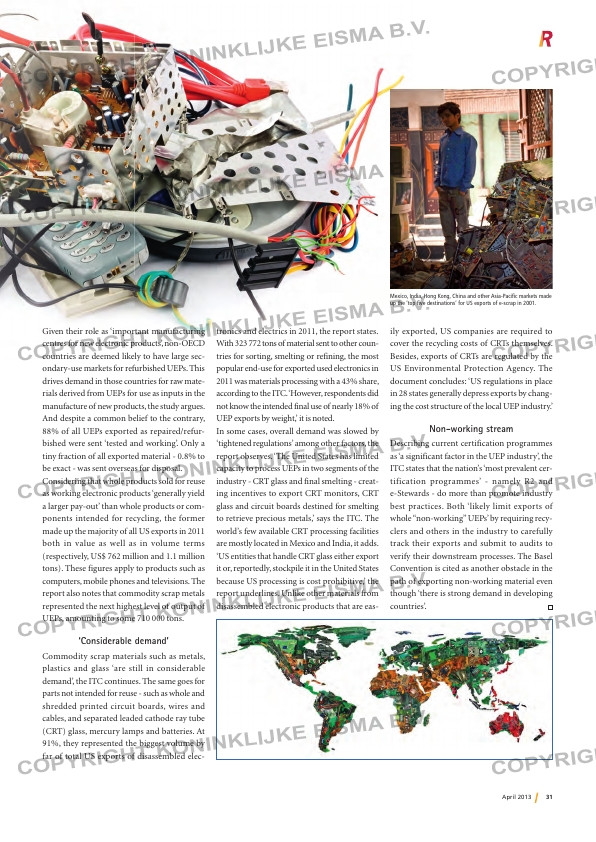Page 31 from: April 2013

31April 2013
Given their role as ‘important manufacturing
centres for new electronic products’, non-OECD
countries are deemed likely to have large sec-
ondary-use markets for refurbished UEPs. This
drives demand in those countries for raw mate-
rials derived from UEPs for use as inputs in the
manufacture of new products, the study argues.
And despite a common belief to the contrary,
88% of all UEPs exported as repaired/refur-
bished were sent ‘tested and working’. Only a
tiny fraction of all exported material – 0.8% to
be exact – was sent overseas for disposal.
Considering that whole products sold for reuse
as working electronic products ‘generally yield
a larger pay-out’ than whole products or com-
ponents intended for recycling, the former
made up the majority of all US exports in 2011
both in value as well as in volume terms
(respectively, US$ 762 million and 1.1 million
tons). These figures apply to products such as
computers, mobile phones and televisions. The
report also notes that commodity scrap metals
represented the next highest level of output of
UEPs, amounting to some 710 000 tons.
‘Considerable demand’
Commodity scrap materials such as metals,
plastics and glass ‘are still in considerable
demand’, the ITC continues. The same goes for
parts not intended for reuse – such as whole and
shredded printed circuit boards, wires and
cables, and separated leaded cathode ray tube
(CRT) glass, mercury lamps and batteries. At
91%, they represented the biggest volume by
far of total US exports of disassembled elec-
tronics and electrics in 2011, the report states.
With 323 772 tons of material sent to other coun-
tries for sorting, smelting or refining, the most
popular end-use for exported used electronics in
2011 was materials processing with a 43% share,
according to the ITC. ‘However, respondents did
not know the intended final use of nearly 18% of
UEP exports by weight,’ it is noted.
In some cases, overall demand was slowed by
‘tightened regulations’ among other factors, the
report observes. ‘The United States has limited
capacity to process UEPs in two segments of the
industry – CRT glass and final smelting – creat-
ing incentives to export CRT monitors, CRT
glass and circuit boards destined for smelting
to retrieve precious metals,’ says the ITC. The
world’s few available CRT processing facilities
are mostly located in Mexico and India, it adds.
‘US entities that handle CRT glass either export
it or, reportedly, stockpile it in the United States
because US processing is cost prohibitive,’ the
report underlines. Unlike other materials from
disassembled electronic products that are eas-
ily exported, US companies are required to
cover the recycling costs of CRTs themselves.
Besides, exports of CRTs are regulated by the
US Environmental Protection Agency. The
document concludes: ‘US regulations in place
in 28 states generally depress exports by chang-
ing the cost structure of the local UEP industry.’
Non-working stream
Describing current certification programmes
as ‘a significant factor in the UEP industry’, the
ITC states that the nation’s ‘most prevalent cer-
tification programmes’ – namely R2 and
e-Stewards – do more than promote industry
best practices. Both ‘likely limit exports of
whole “non-working” UEPs’ by requiring recy-
clers and others in the industry to carefully
track their exports and submit to audits to
verify their downstream processes. The Basel
Convention is cited as another obstacle in the
path of exporting non-working material even
though ‘there is strong demand in developing
countries’.
Mexico, India, Hong Kong, China and other Asia-Pacifi c markets made
up the ‘top fi ve destinations’ for US exports of e-scrap in 2001.
RI-3_E-Scrap.indd 31 08-04-13 09:16



